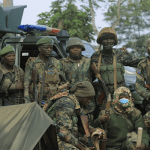The United States military has announced that it will reduce its presence in Iraq from 5,200 to 3,000 troops this month, formalising a move that had been long expected.
The U.S and Iraq in June affirmed their commitment to the reduction of American troops in the country in coming months, with no plans by Washington to maintain permanent bases or a permanent military presence.
The U.S has about 5,200 troops that were deployed in Iraq to fight the armed group ISIL (ISIS).
Officials in the U.S-led coalition said Iraqi forces are now mostly able to handle the ISIL remnants on their own.
The US invaded Iraq in 2003 and left in 2011, but returned in 2014 after ISIL overran large parts of the country.
The remaining U.S forces will continue advising and assisting Iraqi security forces as they attempt to root out ISIL fighters, a senior U.S official said.
Last month, during a meeting with the Iraqi prime minister, Trump redoubled his promise to withdraw the US troops still in Iraq.
Trump’s meeting with the Iraqi Prime Minister Mustafa al-Kadhimi came amid a new spike in tensions between Washington and Tehran after Washington said it would seek to reinstate all previously suspended US sanctions on neighbouring Iran at the United Nations.
Iraq and Iran have close political, economic, and military ties. Fears of open conflict between the US and Iran grew in January after an American drone strike near Baghdad’s airport killed top Iranian General Qassem Soleimani and Iraqi militia leader Abu Mahdi al-Muhandis.
Angry Iraqi legislators, spurred on by Shia political factions, passed a non- binding resolution to remove all US-led coalition forces from the country.
In response to the Soleimani killing, Iran launched a ballistic missile attack on al-Asad airbase in Iraq, which resulted in traumatic brain injuries to more than 100 American troops.
Two months later, US fighter jets struck five sites in retaliation, targeting Iranian-backed Shia militia members believed responsible for the January missile attack.
The United States military has announced that it will reduce its presence in Iraq from 5,200 to 3,000 troops this month, formalising a move that had been long expected.
The U.S and Iraq in June affirmed their commitment to the reduction of American troops in the country in coming months, with no plans by Washington to maintain permanent bases or a permanent military presence.
The U.S has about 5,200 troops that were deployed in Iraq to fight the armed group ISIL (ISIS).
Officials in the U.S-led coalition said Iraqi forces are now mostly able to handle the ISIL remnants on their own.
The US invaded Iraq in 2003 and left in 2011, but returned in 2014 after ISIL overran large parts of the country.
The remaining U.S forces will continue advising and assisting Iraqi security forces as they attempt to root out ISIL fighters, a senior U.S official said.
Last month, during a meeting with the Iraqi prime minister, Trump redoubled his promise to withdraw the US troops still in Iraq.
Trump’s meeting with the Iraqi Prime Minister Mustafa al-Kadhimi came amid a new spike in tensions between Washington and Tehran after Washington said it would seek to reinstate all previously suspended US sanctions on neighbouring Iran at the United Nations.
Iraq and Iran have close political, economic, and military ties. Fears of open conflict between the US and Iran grew in January after an American drone strike near Baghdad’s airport killed top Iranian General Qassem Soleimani and Iraqi militia leader Abu Mahdi al-Muhandis.
Angry Iraqi legislators, spurred on by Shia political factions, passed a non- binding resolution to remove all US-led coalition forces from the country.
In response to the Soleimani killing, Iran launched a ballistic missile attack on al-Asad airbase in Iraq, which resulted in traumatic brain injuries to more than 100 American troops.
Two months later, US fighter jets struck five sites in retaliation, targeting Iranian-backed Shia militia members believed responsible for the January missile attack.
The United States military has announced that it will reduce its presence in Iraq from 5,200 to 3,000 troops this month, formalising a move that had been long expected.
The U.S and Iraq in June affirmed their commitment to the reduction of American troops in the country in coming months, with no plans by Washington to maintain permanent bases or a permanent military presence.
The U.S has about 5,200 troops that were deployed in Iraq to fight the armed group ISIL (ISIS).
Officials in the U.S-led coalition said Iraqi forces are now mostly able to handle the ISIL remnants on their own.
The US invaded Iraq in 2003 and left in 2011, but returned in 2014 after ISIL overran large parts of the country.
The remaining U.S forces will continue advising and assisting Iraqi security forces as they attempt to root out ISIL fighters, a senior U.S official said.
Last month, during a meeting with the Iraqi prime minister, Trump redoubled his promise to withdraw the US troops still in Iraq.
Trump’s meeting with the Iraqi Prime Minister Mustafa al-Kadhimi came amid a new spike in tensions between Washington and Tehran after Washington said it would seek to reinstate all previously suspended US sanctions on neighbouring Iran at the United Nations.
Iraq and Iran have close political, economic, and military ties. Fears of open conflict between the US and Iran grew in January after an American drone strike near Baghdad’s airport killed top Iranian General Qassem Soleimani and Iraqi militia leader Abu Mahdi al-Muhandis.
Angry Iraqi legislators, spurred on by Shia political factions, passed a non- binding resolution to remove all US-led coalition forces from the country.
In response to the Soleimani killing, Iran launched a ballistic missile attack on al-Asad airbase in Iraq, which resulted in traumatic brain injuries to more than 100 American troops.
Two months later, US fighter jets struck five sites in retaliation, targeting Iranian-backed Shia militia members believed responsible for the January missile attack.
The United States military has announced that it will reduce its presence in Iraq from 5,200 to 3,000 troops this month, formalising a move that had been long expected.
The U.S and Iraq in June affirmed their commitment to the reduction of American troops in the country in coming months, with no plans by Washington to maintain permanent bases or a permanent military presence.
The U.S has about 5,200 troops that were deployed in Iraq to fight the armed group ISIL (ISIS).
Officials in the U.S-led coalition said Iraqi forces are now mostly able to handle the ISIL remnants on their own.
The US invaded Iraq in 2003 and left in 2011, but returned in 2014 after ISIL overran large parts of the country.
The remaining U.S forces will continue advising and assisting Iraqi security forces as they attempt to root out ISIL fighters, a senior U.S official said.
Last month, during a meeting with the Iraqi prime minister, Trump redoubled his promise to withdraw the US troops still in Iraq.
Trump’s meeting with the Iraqi Prime Minister Mustafa al-Kadhimi came amid a new spike in tensions between Washington and Tehran after Washington said it would seek to reinstate all previously suspended US sanctions on neighbouring Iran at the United Nations.
Iraq and Iran have close political, economic, and military ties. Fears of open conflict between the US and Iran grew in January after an American drone strike near Baghdad’s airport killed top Iranian General Qassem Soleimani and Iraqi militia leader Abu Mahdi al-Muhandis.
Angry Iraqi legislators, spurred on by Shia political factions, passed a non- binding resolution to remove all US-led coalition forces from the country.
In response to the Soleimani killing, Iran launched a ballistic missile attack on al-Asad airbase in Iraq, which resulted in traumatic brain injuries to more than 100 American troops.
Two months later, US fighter jets struck five sites in retaliation, targeting Iranian-backed Shia militia members believed responsible for the January missile attack.
The United States military has announced that it will reduce its presence in Iraq from 5,200 to 3,000 troops this month, formalising a move that had been long expected.
The U.S and Iraq in June affirmed their commitment to the reduction of American troops in the country in coming months, with no plans by Washington to maintain permanent bases or a permanent military presence.
The U.S has about 5,200 troops that were deployed in Iraq to fight the armed group ISIL (ISIS).
Officials in the U.S-led coalition said Iraqi forces are now mostly able to handle the ISIL remnants on their own.
The US invaded Iraq in 2003 and left in 2011, but returned in 2014 after ISIL overran large parts of the country.
The remaining U.S forces will continue advising and assisting Iraqi security forces as they attempt to root out ISIL fighters, a senior U.S official said.
Last month, during a meeting with the Iraqi prime minister, Trump redoubled his promise to withdraw the US troops still in Iraq.
Trump’s meeting with the Iraqi Prime Minister Mustafa al-Kadhimi came amid a new spike in tensions between Washington and Tehran after Washington said it would seek to reinstate all previously suspended US sanctions on neighbouring Iran at the United Nations.
Iraq and Iran have close political, economic, and military ties. Fears of open conflict between the US and Iran grew in January after an American drone strike near Baghdad’s airport killed top Iranian General Qassem Soleimani and Iraqi militia leader Abu Mahdi al-Muhandis.
Angry Iraqi legislators, spurred on by Shia political factions, passed a non- binding resolution to remove all US-led coalition forces from the country.
In response to the Soleimani killing, Iran launched a ballistic missile attack on al-Asad airbase in Iraq, which resulted in traumatic brain injuries to more than 100 American troops.
Two months later, US fighter jets struck five sites in retaliation, targeting Iranian-backed Shia militia members believed responsible for the January missile attack.
The United States military has announced that it will reduce its presence in Iraq from 5,200 to 3,000 troops this month, formalising a move that had been long expected.
The U.S and Iraq in June affirmed their commitment to the reduction of American troops in the country in coming months, with no plans by Washington to maintain permanent bases or a permanent military presence.
The U.S has about 5,200 troops that were deployed in Iraq to fight the armed group ISIL (ISIS).
Officials in the U.S-led coalition said Iraqi forces are now mostly able to handle the ISIL remnants on their own.
The US invaded Iraq in 2003 and left in 2011, but returned in 2014 after ISIL overran large parts of the country.
The remaining U.S forces will continue advising and assisting Iraqi security forces as they attempt to root out ISIL fighters, a senior U.S official said.
Last month, during a meeting with the Iraqi prime minister, Trump redoubled his promise to withdraw the US troops still in Iraq.
Trump’s meeting with the Iraqi Prime Minister Mustafa al-Kadhimi came amid a new spike in tensions between Washington and Tehran after Washington said it would seek to reinstate all previously suspended US sanctions on neighbouring Iran at the United Nations.
Iraq and Iran have close political, economic, and military ties. Fears of open conflict between the US and Iran grew in January after an American drone strike near Baghdad’s airport killed top Iranian General Qassem Soleimani and Iraqi militia leader Abu Mahdi al-Muhandis.
Angry Iraqi legislators, spurred on by Shia political factions, passed a non- binding resolution to remove all US-led coalition forces from the country.
In response to the Soleimani killing, Iran launched a ballistic missile attack on al-Asad airbase in Iraq, which resulted in traumatic brain injuries to more than 100 American troops.
Two months later, US fighter jets struck five sites in retaliation, targeting Iranian-backed Shia militia members believed responsible for the January missile attack.
The United States military has announced that it will reduce its presence in Iraq from 5,200 to 3,000 troops this month, formalising a move that had been long expected.
The U.S and Iraq in June affirmed their commitment to the reduction of American troops in the country in coming months, with no plans by Washington to maintain permanent bases or a permanent military presence.
The U.S has about 5,200 troops that were deployed in Iraq to fight the armed group ISIL (ISIS).
Officials in the U.S-led coalition said Iraqi forces are now mostly able to handle the ISIL remnants on their own.
The US invaded Iraq in 2003 and left in 2011, but returned in 2014 after ISIL overran large parts of the country.
The remaining U.S forces will continue advising and assisting Iraqi security forces as they attempt to root out ISIL fighters, a senior U.S official said.
Last month, during a meeting with the Iraqi prime minister, Trump redoubled his promise to withdraw the US troops still in Iraq.
Trump’s meeting with the Iraqi Prime Minister Mustafa al-Kadhimi came amid a new spike in tensions between Washington and Tehran after Washington said it would seek to reinstate all previously suspended US sanctions on neighbouring Iran at the United Nations.
Iraq and Iran have close political, economic, and military ties. Fears of open conflict between the US and Iran grew in January after an American drone strike near Baghdad’s airport killed top Iranian General Qassem Soleimani and Iraqi militia leader Abu Mahdi al-Muhandis.
Angry Iraqi legislators, spurred on by Shia political factions, passed a non- binding resolution to remove all US-led coalition forces from the country.
In response to the Soleimani killing, Iran launched a ballistic missile attack on al-Asad airbase in Iraq, which resulted in traumatic brain injuries to more than 100 American troops.
Two months later, US fighter jets struck five sites in retaliation, targeting Iranian-backed Shia militia members believed responsible for the January missile attack.
The United States military has announced that it will reduce its presence in Iraq from 5,200 to 3,000 troops this month, formalising a move that had been long expected.
The U.S and Iraq in June affirmed their commitment to the reduction of American troops in the country in coming months, with no plans by Washington to maintain permanent bases or a permanent military presence.
The U.S has about 5,200 troops that were deployed in Iraq to fight the armed group ISIL (ISIS).
Officials in the U.S-led coalition said Iraqi forces are now mostly able to handle the ISIL remnants on their own.
The US invaded Iraq in 2003 and left in 2011, but returned in 2014 after ISIL overran large parts of the country.
The remaining U.S forces will continue advising and assisting Iraqi security forces as they attempt to root out ISIL fighters, a senior U.S official said.
Last month, during a meeting with the Iraqi prime minister, Trump redoubled his promise to withdraw the US troops still in Iraq.
Trump’s meeting with the Iraqi Prime Minister Mustafa al-Kadhimi came amid a new spike in tensions between Washington and Tehran after Washington said it would seek to reinstate all previously suspended US sanctions on neighbouring Iran at the United Nations.
Iraq and Iran have close political, economic, and military ties. Fears of open conflict between the US and Iran grew in January after an American drone strike near Baghdad’s airport killed top Iranian General Qassem Soleimani and Iraqi militia leader Abu Mahdi al-Muhandis.
Angry Iraqi legislators, spurred on by Shia political factions, passed a non- binding resolution to remove all US-led coalition forces from the country.
In response to the Soleimani killing, Iran launched a ballistic missile attack on al-Asad airbase in Iraq, which resulted in traumatic brain injuries to more than 100 American troops.
Two months later, US fighter jets struck five sites in retaliation, targeting Iranian-backed Shia militia members believed responsible for the January missile attack.














